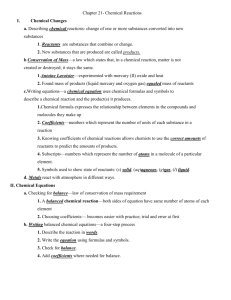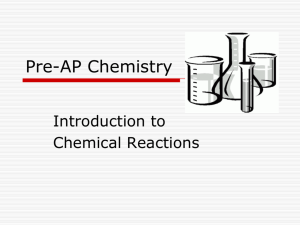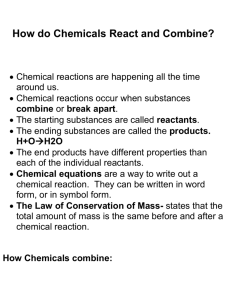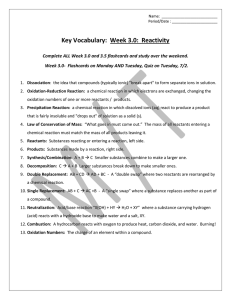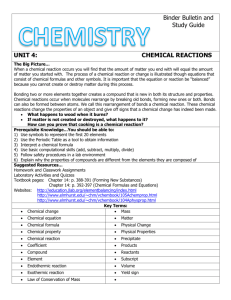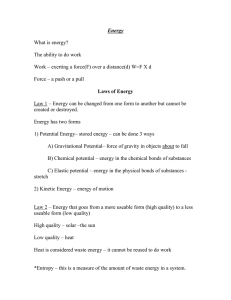Chapter 7 Chemical Reactions
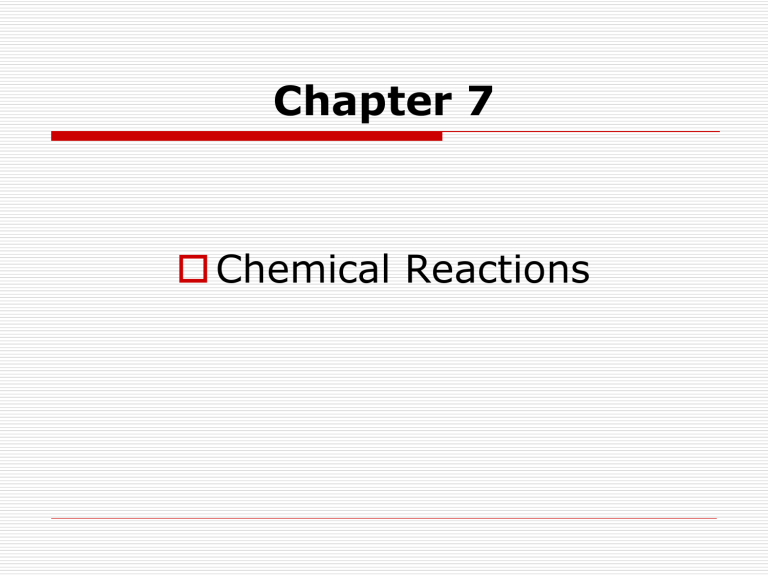
Chapter 7
Chemical Reactions
7.1 Describing Chemical Reactions
What is a chemical reaction?
Demos
Chemical Reaction : is when a substance undergoes a chemical change to produce a new substance or substances
7 different types of chemical reactions
Chemical equations: are used to represent a chemical change/reaction
Ex. 2 H
2
+ O
2
2 H
2
O
Reactants : are the substances that undergo chemical change (bonds broken) (ingredients)
Products : are the new substances produced by the change (new bonds made) (cookies)
Reading Chemical equations
+ sign = “reacts with”
sign = “to produce”, yields
Mole is an amount of a substance that contains 6.02X10
23 particles. So rather than using atoms, molecules or ions we use the MOLE
Coefficient = # of moles
Mole continued
Shoes come in pairs,
Eggs in a dozen.
Particles to chemists come in MOLES
Particles can be atoms, molecules, or ions
Law of conservation of mass : states that mass is neither created nor destroyed in a chemical reaction
By ordinary means, we can’t make or destroy matter
ONLY REARRANGE IT!!!!!!!!
Balancing Equations
When writing chemical equations, the law of conservation of mass must be followed.
We must have the same amount of each element on both sides of the equation
Coefficients : are used to show proportions of reactants and products)
PERFECT PRACTICE,
MAKES PERFECT!!!!!!
2 H
2 (g)
+O
2 (g)
2 H
2
O
(l)
Coefficients represent the number of units of each substance in the reaction
Subscripts represent the number of atoms in the molecule
Symbols show the state of reactants
(s) solid, (aq) aqueous), (g) gas, (l) liquid
Discussion question
Why are coefficients important?
Chemists need to know how much of a reactant will produce a certain amount of a product.
7.2 Types of Reactions
7 types of reactions
Synthesis: is a reaction in which two or more substances react to form a more complex single substance
A+B C
Ex. 2 Na + Cl
2
2 NaCl
Decomposition Reaction: is a reaction in which a compound breaks down into two or more simpler substances
AB A+B
Ex. 2 H
2
0 2 H
2
+ O
2
Compost pile, digesting food, electrolysis (breaking down H electricity)
2
O with
Combustion Reaction: is reaction where a substance reacts rapidly with oxygen.
Flammability or explosiveness
Ex. CH
4
+ 2 O
2
CO
2
+ 2 H
Ex. Burning any type of fuel
2
O
Usually produces CO
2
(greenhouse gas)
Oxidation Reaction: are reactions where a substance reacts slowly with the oxygen in air or water
Happens with metals
“rust” or “tarnish”
Ex. 2 Ca + O
2
2 CaO
Single Replacement Reaction: is a reaction where one element takes the place of another element
A+BC AC+B or D+BC BD +C
Cu + 2 AgNO
3
2 Ag + Cu(NO
3
)
2
Double Replacement: is a reaction where 2 elements replace each other
AB+CD AD+CB
CaCO
3
+ 2 HCl CaCl
2
+ H
2
CO
3
Discussion Question:
What two Chemical reactions are
“opposites” of each other and why?
Synthesis and decomposition; in synthesis multiple substances combine to form a new one, while decomposition a single substance breaks apart into multiple simpler substances
Exothermic Reactions : are reactions that release energy into their surroundings
Give off heat (exergonic)
Ex. Combustion Reactions
Ex. Burning fossil fuels
Endothermic Reaction : is a reaction where heat energy is absorbed by its surroundings
Ice absorbs heat to melt into water
Gets colder (endergonic)
Ex. Ice pack and decomposition of mercury
Increasing Reaction Rate:
1. Temperature
2. Surface area
3. Stirring
4. Concentration of Reactants
5. Catalyst: is a substance that affects reaction rate without being used up.
Discussion Question:
How are chemical bonds involved in energy exchanges?
Breaking bonds requires energy; forming bonds releases energy.
